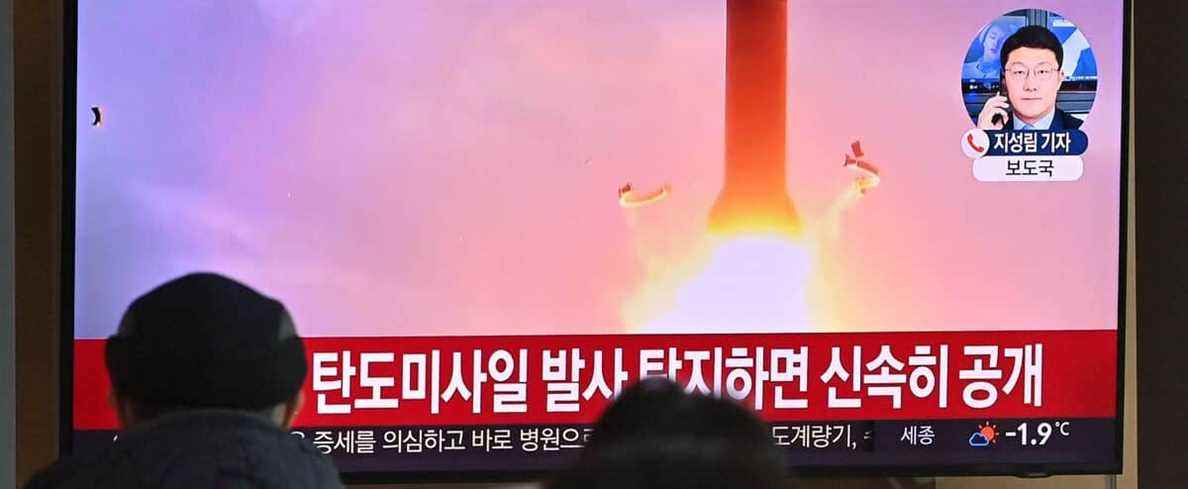North Korea on Monday confirmed it launched its most powerful missile since 2017 the day before, according to state media, capping a month of serial tests, raising fears of a resumption of nuclear and intercontinental missile testing.
North Korea has never tested so many missiles in a month as with the seven tests conducted in January.
The last significant series of shootings dates back to 2019, after the breakdown of negotiations between its leader Kim Jong Un and then US President Donald Trump (2017-2021).
“An evaluation firing of the Hwasong-12 intermediate and long range surface-to-surface ballistic missile was carried out on Sunday”, which “confirmed the precision, safety and effectiveness” of the device, in production, North Korean state news agency KCNA announced on Monday.
The South Korean Joint Chiefs of Staff said on Sunday that it had detected “an intermediate-range ballistic missile fired at a high angle” at dawn. A high angle shot means the missile does not reach its maximum range.
KCNA said on Monday that the test was carried out using the “highest angle launch system” out of concern for the safety of neighboring countries, and that the warhead of the missile contained a camera.
The official agency published images that would have been taken from space by this camera.
For South Korea, the North is following “a similar path” to that of 2017, when tensions were at their height on the Korean peninsula.
Pyongyang “is close to breaking the self-imposed moratorium” on nuclear and intercontinental ballistic missile testing, South Korean President Moon Jae-in said on Sunday.
The missile was fired from the northern province of Jagang, from where North Korea has launched what it claims are hypersonic missiles from in recent months.
It reached a maximum altitude of 2,000 km and traveled about 800 km in 30 minutes before falling into the Sea of Japan, said the South Korean staff.
Pyongyang previously tested a Hwasong-12 missile in 2017, which traveled 787 km and reached a maximum altitude of 2,111 km.
At the time, analysts had calculated that this projectile had the capacity to travel 4500 km, and therefore to reach the island of Guam, an American territory in the Pacific Ocean.
“Gun Addict”
In 2017, the launch of a Hwasong-12 was quickly followed by the firing of a Hwasong-15, which can reach North America, said Hong Min of the Korea Institute for National Unification.
The latest test “flags the possibility of an intercontinental ballistic missile launch and the imminent breach of the moratorium using the Hwasong-12 launch map,” he said in a note.
Since the inauguration of President Joe Biden in January 2021, Pyongyang has rejected the various dialogue proposals made by Washington. And Kim Jong Un reaffirmed in December that his priority was to modernize the country’s arsenal.
These North Korean trials come at a delicate time for the region: China, the only major ally of the North Korean regime, is hosting the Winter Olympics in February and South Korea is holding a presidential election in March.
Pyongyang prepares to celebrate the 80th birth anniversary of Kim’s father, the late Kim Jong Il, in February, then the 110and birthday of his grandfather, Kim Il Sung, the country’s founding leader, in April.
With Pyongyang struggling economically with reports of soaring food prices, leaders could be in search of quick profits, said Lim Eul-chul, a professor of North Korean studies at Kyungnam University. from Seoul.
Kim Jong Un is “addicted to advanced weapons”, he says.
According to this expert, North Korea is trying to strengthen its advanced weaponry to the point that the United States would be forced to “surrender” to its demands.
“He sees success in the military sector as the best weapon to restore his pride and elevate his leadership status and that of the nation to the highest level,” Lim said.
